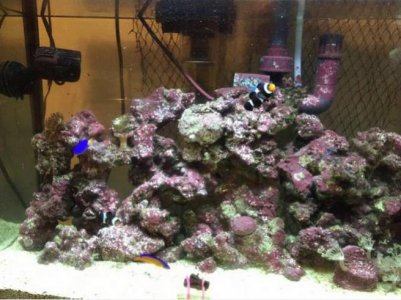Au_ThatHurt
New member
Hey everyone. I am diving into the hobby for the first time this weekend and have been preparing for quite some time now...nervous as hell. I am purchasing this tank (attached is a pic) and moving the 30g across state lines (about an hour and a half away) this weekend. After planning for the move I have had many questions come to mind that I could use some help with.
Some info: 350$ total and comes with an octopus skimmer, heater, a powerhead (not sure what type), salinity/temp gauge, LED light (unsure what kind atm), all the LR, livestock (two clowns, yellowtail damsel, neon dottyback & an orange and purple lobster), food/cleaning supplies, and test kits. The tank has been established for 2 years and it looks to me hmm4
hmm4 as if the owner had taken good care of it.
as if the owner had taken good care of it.
1) What are your initial thoughts on the look of the tank!? I noticed, what looks to be an aiptasia bloom on the right side of the pic? Can I scrub/rid the affected rocks? Could the addition of a peppermint shrimp or two solve my issue? (not sure if the lobster would have to be removed, if so would my LFS take the lobster?) I know aiptasia is normally brown but if it was not given enough light I have heard they can turn a white color.
2) do I need to have a portable heater or would putting the livestock in a cooler for that time be fine for an hour and a half? (two clowns, neon dotty, purple/orange lobster)
3) Should I just keep the old substrate or would mixing some of the old substrate with new live substrate be a good idea?
If you have any major things that come to mind that I need to make sure I do during this process it would be much appreciated if you let me know. I know that purchasing an established tank is not recommended for one starting in the hobby but I feel as if I needed to jump on the opportunity at this deal as I am pretty sure I would spend a ton more for the same setup if new. I will be finished with making a 20g sump for the setup later today and really care for the well being of these fish and the lobster dood so any info that you have at all will help me immensely. Thanks for your help guys...wouldn't have any idea on what I am doing if it were not for you!
Some info: 350$ total and comes with an octopus skimmer, heater, a powerhead (not sure what type), salinity/temp gauge, LED light (unsure what kind atm), all the LR, livestock (two clowns, yellowtail damsel, neon dottyback & an orange and purple lobster), food/cleaning supplies, and test kits. The tank has been established for 2 years and it looks to me
1) What are your initial thoughts on the look of the tank!? I noticed, what looks to be an aiptasia bloom on the right side of the pic? Can I scrub/rid the affected rocks? Could the addition of a peppermint shrimp or two solve my issue? (not sure if the lobster would have to be removed, if so would my LFS take the lobster?) I know aiptasia is normally brown but if it was not given enough light I have heard they can turn a white color.
2) do I need to have a portable heater or would putting the livestock in a cooler for that time be fine for an hour and a half? (two clowns, neon dotty, purple/orange lobster)
3) Should I just keep the old substrate or would mixing some of the old substrate with new live substrate be a good idea?
If you have any major things that come to mind that I need to make sure I do during this process it would be much appreciated if you let me know. I know that purchasing an established tank is not recommended for one starting in the hobby but I feel as if I needed to jump on the opportunity at this deal as I am pretty sure I would spend a ton more for the same setup if new. I will be finished with making a 20g sump for the setup later today and really care for the well being of these fish and the lobster dood so any info that you have at all will help me immensely. Thanks for your help guys...wouldn't have any idea on what I am doing if it were not for you!
Attachments
Last edited:

